The Integration of Internet of Things IoT in Modern Software Solutions brings forth a revolutionary wave in how we perceive and utilize technology. As devices become smarter and more interconnected, the potential for innovation in software solutions expands exponentially. This integration not only enhances efficiency but also fosters new opportunities for businesses across various sectors, making it essential to understand its implications and applications.

In this digital age, where connectivity is paramount, the IoT serves as a bridge linking various platforms and devices. It allows for real-time data exchange and automation, fundamentally transforming operational processes. As we delve deeper into this topic, we will explore the myriad ways IoT is reshaping modern software, highlighting the benefits and challenges that come with it.
In today’s fast-paced world, the need for effective communication has never been more essential. Whether it’s in our personal lives or professional settings, the ability to convey ideas clearly and concisely can make all the difference in achieving our goals. In this article, we’ll explore the nuances of communication, the various forms it takes, and tips to enhance your skills.
Communication is a fundamental aspect of human interaction. It is not just about speaking or writing; it also encompasses non-verbal cues such as body language, facial expressions, and tone of voice. All these elements work together to create a comprehensive message that can be understood in multiple ways. Hence, being aware of how you present yourself can significantly affect how your message is received.
One of the primary forms of communication is verbal communication. This includes face-to-face conversations, telephone calls, and video conferences. Being articulate and confident in your speech can greatly enhance your interactions. A few strategies to improve verbal communication are:
- Practice Active Listening: This involves fully concentrating, understanding, responding, and remembering what is being said. It shows respect and encourages the speaker to share more.
- Be Clear and Concise: Avoid jargon or overly complex language. Stick to the point to ensure your audience understands your message easily.
- Adjust Your Tone: Your tone can convey emotional subtleties that words may not express. Be mindful of how your tone may affect the listener’s perception of your message.
Written communication is another critical aspect that provides a record of your thoughts and ideas. Emails, reports, and social media posts are common forms of written communication in both personal and professional contexts. To enhance your written communication skills, consider the following tips:
- Know Your Audience: Tailor your writing style to suit the preferences and expectations of your audience. This can vary significantly between formal reports and casual social media updates.
- Use Proper Grammar and Spelling: Errors in writing can undermine your credibility. Always proofread your work before sending or publishing it.
- Be Structure-Conscious: Organize your writing logically. Use headings, bullet points, and paragraphs to break up text and make it easier to digest.
Non-verbal communication often speaks louder than words. It includes facial expressions, gestures, posture, and even eye contact. Understanding and utilizing non-verbal cues can enhance the effectiveness of your communication. Here are some points to consider:
- Maintain Eye Contact: This demonstrates confidence and helps build trust with your audience.
- Be Mindful of Your Body Language: Open postures, such as uncrossed arms, can signal that you are approachable and engaged.
- Use Gestures Wisely: Hand movements can emphasize your point, but excessive gestures might distract from your message.
In today’s digital age, online communication has become increasingly prevalent. Platforms such as social media, emails, and messaging apps have altered how we interact with one another. While these tools offer convenience, they also come with unique challenges. Here are some considerations for effective online communication:
- Be Cautious with Tone: Without vocal intonation, written messages may be misinterpreted. Use emojis or punctuation to clarify your tone when necessary.
- Respond Promptly: In the fast-paced online environment, timely responses can showcase your professionalism and respect for others’ time.
- Know When to Move Offline: Some conversations are best had face-to-face or via video call. Recognize when it’s time to switch mediums for clarity.
Effective communication is not just about delivering a message but also about ensuring the message is received and understood as intended. Feedback plays a crucial role here. Encouraging feedback can help you gauge whether your message was clear and if the recipient has questions or concerns. Here are a few strategies to solicit and give feedback:
- Ask Open-Ended Questions: This encourages a dialogue rather than a simple yes or no answer, allowing for more in-depth discussions.
- Be Receptive: Show that you value the feedback, whether it is positive or constructive. It fosters a culture of open communication.
- Provide Constructive Feedback: When offering feedback, focus on specific behaviors rather than personal attributes. This makes it easier for the recipient to improve.
In conclusion, mastering the art of communication is a continuous journey that requires practice and self-awareness. Whether through verbal, written, or non-verbal means, effective communication can lead to stronger relationships, increased collaboration, and a more harmonious environment, both personally and professionally. By implementing these strategies and consciously improving your skills, you can become a more effective communicator, leading to greater success in all areas of your life.




